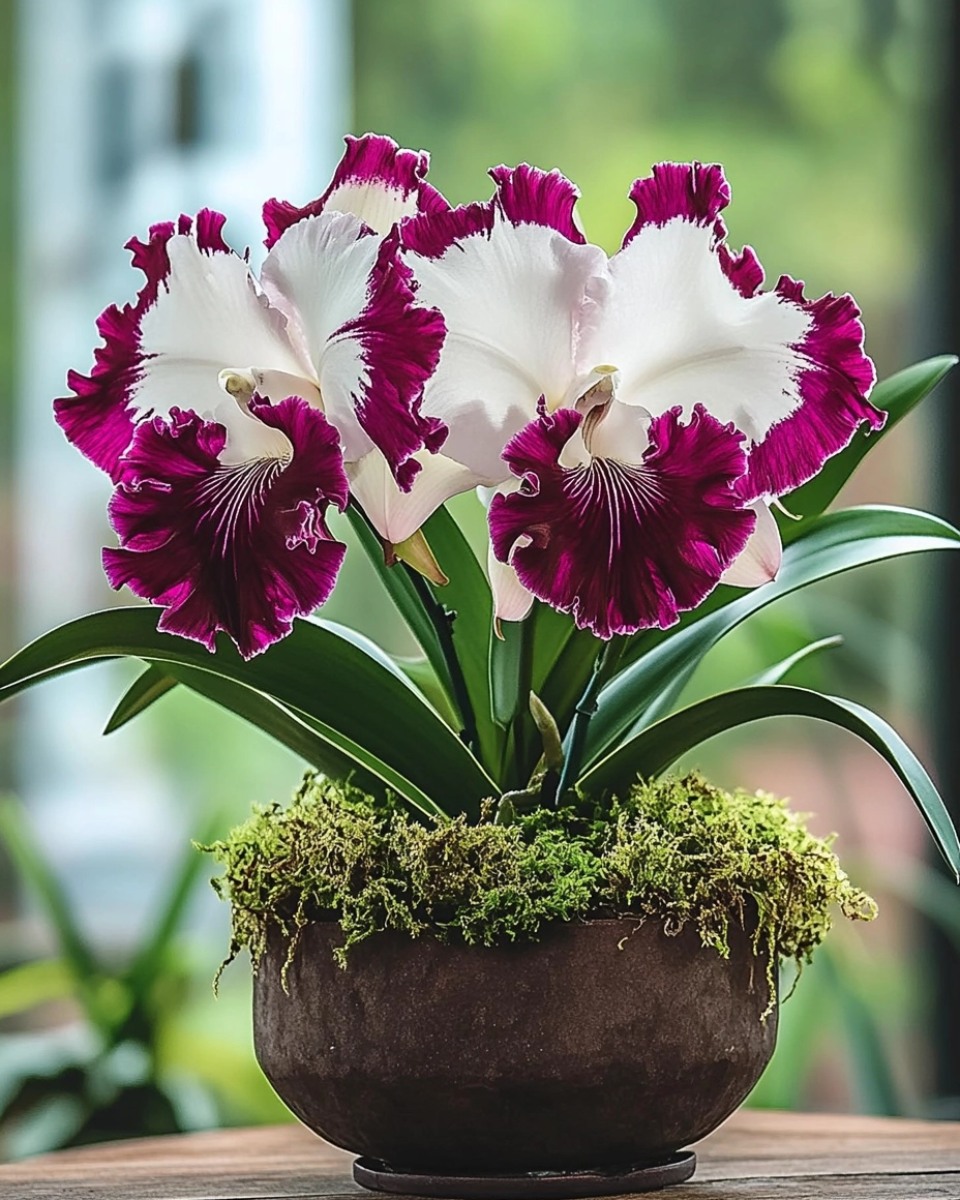Cattleya orchids are truly magnificent, known for their breathtaking blooms and vibrant colors. The combination of white and burgundy in the Cattleya orchid creates a striking contrast, making it a standout feature in any home or garden. While Cattleyas are hardy and resilient, they do require specific care to thrive and produce their stunning flowers. If you want to keep your exotic Cattleya orchid blooming beautifully, follow this easy guide to help it flourish!
✨ Why Choose the Cattleya Orchid? ✨
The Cattleya orchid, often referred to as the “queen of orchids,” is celebrated for its large, showy flowers, making it one of the most sought-after orchids in the world. The unique color combination of white and burgundy in many Cattleya varieties adds an air of elegance and luxury to your space. Plus, these orchids have a pleasant fragrance, making them an excellent addition to any room. However, to enjoy their beauty year-round, it’s essential to understand their care needs.
☀️ Light: The Key to Vibrant Blooms
Cattleya orchids love bright, indirect light. They thrive in spaces where they receive plenty of light but without the harsh effects of direct sunlight. Direct midday sun can scorch their delicate leaves, causing sunburns and hindering growth.
Ideal Lighting Locations:
Place your Cattleya orchid near an east- or west-facing window where it can get bright light but avoid the harsh midday sun.
If your orchid is near a south-facing window, filter the sunlight with sheer curtains to prevent overheating.
Cattleyas need light to photosynthesize and bloom, so if you notice your plant isn’t blooming or growing well, it might not be getting enough light.
💦 Water: Hydration Without Overwatering
Cattleya orchids require a consistent watering schedule. Water your orchid once a week or whenever the potting mix feels dry. However, avoid overwatering, as soggy roots can lead to root rot, which can quickly harm the plant.
Watering Tips:
Allow the roots to dry slightly between waterings to prevent excess moisture, which can cause root rot.
Check the potting medium: If the top inch or so of the soil is dry, it’s time to water.
Water thoroughly: Water until it drains out of the bottom of the pot, ensuring that the roots receive enough hydration.
It’s best to use lukewarm water, as cold water can shock the roots, and make sure the pot has good drainage to keep the roots healthy.
🌱 Humidity: A Love for Moisture
Cattleya orchids thrive in a humidity range of 50-70%. To ensure your orchid remains healthy and vibrant, you may need to increase the humidity levels around the plant, especially in dry indoor environments.
Ways to Boost Humidity:
Mist lightly around the plant with a spray bottle to maintain moisture, but avoid soaking the leaves or flowers.
Use a humidity tray: Place your Cattleya orchid on a shallow tray filled with pebbles and water. Ensure the pot is not sitting directly in the water, as this can lead to root rot.
Humidifier: Using a humidifier in the room where your orchid is located can help maintain the right moisture levels.
🌡️ Temperature: Warm Days and Cool Nights
Cattleya orchids prefer warm daytime temperatures between 70-85°F (21-29°C). During the night, they appreciate cooler temperatures, ideally between 55-65°F (13-18°C). These temperature fluctuations simulate the natural day and night cycle of the plant’s native environment.
Temperature Tips:
Keep the orchid away from drafts or areas with temperature extremes, such as near air conditioners, heaters, or windows that may get too cold.
Cattleyas love warmth during the day, but cool nights will help trigger blooming, so try to create a slight temperature difference between day and night.
✂️ Repotting: Refreshing for Healthy Growth
Repotting your Cattleya orchid is important for its health and longevity. The potting mix will degrade over time, so refreshing the medium every 2-3 years ensures your orchid gets the nutrients it needs to grow. Repotting also gives the roots more space to expand and encourages healthy new growth.
When to Repot:
If the orchid is outgrowing its pot or the potting mix is breaking down, it’s time to repot.
Repotting is best done after the plant has finished blooming, as this will minimize stress to the plant.
Repotting Tips:
Choose a pot that is slightly larger than the current one. Orchids do not like too much space, so a pot that’s only an inch or two bigger is ideal.
Use a well-draining orchid mix, which is typically made of bark, perlite, and sphagnum moss, to ensure good aeration for the roots.
Gently remove the orchid from its old pot, trim any dead or rotting roots, and place it in the new pot with fresh potting mix. Be sure the roots are spread out, and avoid burying the crown of the plant.
🌿 Cattleya Orchid Care Summary
Caring for a Cattleya orchid doesn’t have to be difficult. By providing the right light, temperature, humidity, and watering routine, your orchid will thrive and reward you with its stunning, fragrant blooms. Follow these simple steps:
Light: Bright, indirect light is essential.
Water: Water weekly, letting the roots dry slightly between waterings.
Humidity: Keep humidity levels between 50-70%, misting lightly if needed.
Temperature: Warm days (70-85°F) and cooler nights (55-65°F) are perfect.
Repotting: Refresh the potting mix every 2-3 years for optimal health.
With proper care, your white and burgundy Cattleya orchid will not only survive but thrive, becoming a gorgeous centerpiece in your home. Watch as it bursts into bloom, adding exotic beauty and elegance to any space. 🌸🌿✨
Happy gardening, and may your Cattleya orchid fill your space with vibrant colors and lasting beauty!
More Articles You Might Like
-
Texas Toast Sloppy Joes: The Crunchy, Cheesy Upgrade You Didn’t Know You Needed
There’s something timeless about sloppy joes. For generations, this saucy, savory, and slightly sweet ground beef sandwich has been a go-to comfort food in American kitchens. It’s quick, filling, and family-friendly—perfect for busy weeknights. But what if we told you there’s a way to take this classic dish up a notch? Enter the Texas Toast…
-
Classic Pig Pickin’ Cake
When it comes to Southern desserts, few sweets shine as brightly as the Classic Pig Pickin’ Cake. This nostalgic cake, sometimes called a “Mandarin Orange Cake,” has roots deep in Southern tradition. It gets its playful name from its frequent appearance at pig pickin’s—Southern-style barbecue gatherings where communities come together to enjoy slow-cooked pork, sides,…
-
Lemon Garlic Butter Chicken with Creamy Parmesan Pasta
There’s something irresistible about the combination of tender, golden-browned chicken paired with a creamy pasta coated in Parmesan cheese. Add the brightness of lemon, the depth of garlic, and the richness of butter, and you have a recipe that feels indulgent yet approachable enough for a weeknight dinner. Lemon Garlic Butter Chicken with Creamy Parmesan…



